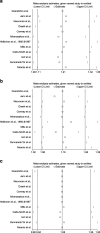Long-term outcomes and quality of life of patients with Hirschsprung disease: a systematic review and meta-analysis
- PMID: 32164539
- PMCID: PMC7066788
- DOI: 10.1186/s12876-020-01208-z
Long-term outcomes and quality of life of patients with Hirschsprung disease: a systematic review and meta-analysis
Abstract
Background: Advances in surgical techniques and perioperative care have improved the short- and mid-term postoperative outcomes of patients with Hirschsprung disease (HD). However, the long-term outcomes of these patients (older than 10 years) have not been fully investigated. The aim of this systematic review is to clarify the prevalence of long-term outcomes and the quality of life of these patients.
Methods: PubMed, AMED, Cochrane Library, CINAHL and PsycINFO databases were searched from inception to October 2018, following the Meta-analysis of Observational Studies in Epidemiology (MOOSE) guideline. Original studies reporting the outcomes of patients older than ten years with HD were selected and reviewed. The overall prevalence of fecal incontinence, constipation, bowel function score, bladder dysfunction symptoms, and patients' quality of life were extracted from the included studies and pooled through the random-effects meta-analysis model. The heterogeneity and variation in the pooled estimations were evaluated by Cochrane's Q test and the I2 test. The sensitivity analysis was conducted by the sequential omission of individual studies. Publication bias was evaluated by Egger's linear regression test. The whole procedure was conducted with Stata (version 14).
Results: In total, 3406 articles were identified from the literature search, among which twelve studies, including 625 patients, were included for analysis. The pooled prevalences of fecal incontinence, constipation, and bladder dysfunction symptoms and good to excellent bowel function scores were 0.20 (95% CI 0.13-0.28), 0.14 (95% CI 0.06-0.25), 0.07 (95% CI 0.04-0.12), and 0.95 (95% CI: 0.91-0.97), respectively; the pooled mean score of gastrointestinal-related quality of life was 118 (95% CI: 112.56-123.44).
Conclusions: HD patients older than ten years old have an overall high prevalence of fecal incontinence and a low quality of life. Targeted and evidence-based follow-up procedures and transitional care are essential to meet these patients' long-term care needs. Prospective and multicenter research that focuses on the attributes and predictors of the long-term prognosis of patients with HD are necessary.
Keywords: Children; Constipation; Fecal incontinence; Follow-up; Hirschsprung disease; Long-term outcome; Prevalence; Quality of life.
Conflict of interest statement
The authors declare that they have no competing interests.
Figures



Similar articles
-
The long-term quality of life outcomes in adolescents with Hirschsprung disease.J Pediatr Surg. 2018 Dec;53(12):2430-2434. doi: 10.1016/j.jpedsurg.2018.08.036. Epub 2018 Sep 5. J Pediatr Surg. 2018. PMID: 30244941
-
Hirschsprung disease-Bowel function beyond childhood.Semin Pediatr Surg. 2017 Oct;26(5):322-327. doi: 10.1053/j.sempedsurg.2017.09.008. Epub 2017 Sep 9. Semin Pediatr Surg. 2017. PMID: 29110829 Review.
-
Generic and disease-specific health-related quality of life in patients with Hirschsprung disease: A systematic review and meta-analysis.World J Gastroenterol. 2022 Apr 7;28(13):1362-1376. doi: 10.3748/wjg.v28.i13.1362. World J Gastroenterol. 2022. PMID: 35645538 Free PMC article.
-
Long-Term Outcomes and Quality of Life in Patients after Soave Pull-Through Operation for Hirschsprung's Disease: An Observational Retrospective Study.Eur J Pediatr Surg. 2018 Oct;28(5):445-454. doi: 10.1055/s-0037-1604115. Epub 2017 Jul 24. Eur J Pediatr Surg. 2018. PMID: 28738437
-
Quality of life outcomes in children with Hirschsprung disease.J Pediatr Surg. 2017 Dec;52(12):2006-2010. doi: 10.1016/j.jpedsurg.2017.08.043. Epub 2017 Sep 2. J Pediatr Surg. 2017. PMID: 28927976
Cited by
-
Physical self-concept and ability to swim in patients born with anorectal malformation and Hirschsprung's disease: a case control study.BMC Pediatr. 2022 Dec 15;22(1):717. doi: 10.1186/s12887-022-03782-5. BMC Pediatr. 2022. PMID: 36517764 Free PMC article.
-
RET Signaling Persists in the Adult Intestine and Stimulates Motility by Limiting PYY Release From Enteroendocrine Cells.Gastroenterology. 2024 Mar;166(3):437-449. doi: 10.1053/j.gastro.2023.11.020. Epub 2023 Nov 21. Gastroenterology. 2024. PMID: 37995867 Free PMC article.
-
Post-surgical Outcomes of Different Surgical Techniques in Hirschsprung's Disease: A Literature Review.Cureus. 2023 Oct 14;15(10):e47012. doi: 10.7759/cureus.47012. eCollection 2023 Oct. Cureus. 2023. PMID: 37965402 Free PMC article. Review.
-
Translation and validation of the Hirschsprung and anorectal malformation quality of life (HAQL) questionnaire in a Danish Hirschsprung population.Pediatr Surg Int. 2024 Feb 9;40(1):52. doi: 10.1007/s00383-024-05634-y. Pediatr Surg Int. 2024. PMID: 38334791 Free PMC article.
-
Long-term outcomes of laparoscopic-assisted versus complete transanal endorectal pull-through technique for classic segment Hirschsprung's disease.Pediatr Surg Int. 2024 Dec 13;41(1):26. doi: 10.1007/s00383-024-05924-5. Pediatr Surg Int. 2024. PMID: 39668290
References
-
- Deng X, Wu Y, Zeng L, Zhang J, Zhou J, Qiu R. Comparative analysis of modified laparoscopic Swenson and laparoscopic soave procedure for short-segment Hirschsprung disease in children. Eur J Pediatr Surg. 2015;25(5):430–434. - PubMed
-
- Xia X, Li N, Wei J, Zhang W, Yu D, Zhu T, Feng J. Laparoscopy-assisted versus transabdominal reoperation in Hirschprung's disease for residual aganglionosis and transition zone pathology after transanal pull-through. J Pediatr Surg. 2016;51(4):577–581. doi: 10.1016/j.jpedsurg.2015.10.085. - DOI - PubMed
-
- Ademuyiwa AO, Bode CO, Idiodi-Thomas HO, Elebute OA. Early outcome of open primary pull through versus staged pull through in Hirschsprung's disease: a single Centre experience from Nigeria. Nig Q J Hosp Med. 2012;22(3):164–167. - PubMed
Publication types
MeSH terms
LinkOut - more resources
Full Text Sources

